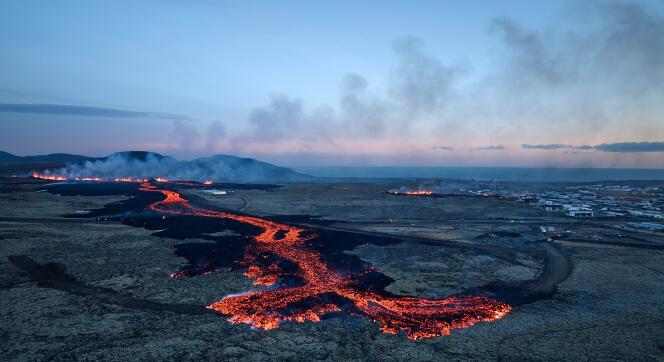


Sirens sounded between 3 and 4 am on Sunday, January 14, on the streets of Grindavik, 40 kilometers southwest of Reykjavik, the Icelandic capital. Residents of the Icelandic town had already been evacuated on November 11, after violent earthquakes split the ground in two, and again on December 18, shortly before the previous volcanic eruption that lasted until December 21.
On Sunday, the hundred or so residents who had chosen to return home despite the known and repeated risks were ordered to leave the town, as were tourists staying at the Blue Lagoon Resort & Spa. The decision was made by the authorities after numerous magnitude 2.5 and 3 earthquakes in the previous few hours and the growing risk of a new eruption.
At 8 am, the first lava explosion lit up the sky and clothed the summit of the Sundhnjukagigar volcano. Images from surveillance cameras broadcast by Icelandic public television were breathtaking.
A few hours later, to the north of the town, a crack appeared in the snow around a perimeter wall that was built in three weeks to protect the Svartsengi geothermal power plant. "Authorities had tried to continue the construction of the wall after the area had been evacuated, but it wasn't enough," said Bjarny Sigmardottir, a Grindavik resident who took refuge in Reykjavik.
Images posted on Instagram by photographers based in Iceland showed that the lava rapidly broke through the wall by capillary action, flowing out on either side of it. The flow had reached the water conduit of the geothermal power plant supplying the city with heating by the late morning. "Fortunately, the entire plant had been shut down after the morning's evacuation," said meteorologist Einar Sveinnbjörnsson.
Just as the worst seemed to be underway in Svartsengi, a new fault emerged from the ground to the southwest of the town. "At midday, we saw lava erupt a few dozen yards from the first houses in the town, then witnessed one and then a second burst into flames," said Sveinnbjörnsson. "It's highly likely that others will suffer the same fate in the coming hours."
Far from home, the people of Grindavik are devastated, watching live on television as the lava sweeps through the streets of their town. "Ours hasn't been damaged yet," said Sigmardottir. "Before this new eruption, we were told that we might be able to return home in a month. Now that hope is fading."
Two more houses were shown catching fire. The lava has now spread to the paved road, accelerating its progress. A dozen more houses are likely to be in its path. This is the first devastating eruption in Iceland since January 23, 1973, when, two days after an earthquake, Eldfell – Icelandic for "mountain of fire" – the volcano on the island of Heimaey in the heart of the Vestmann Islands, awoke.
You have 35% of this article left to read. The rest is for subscribers only.
